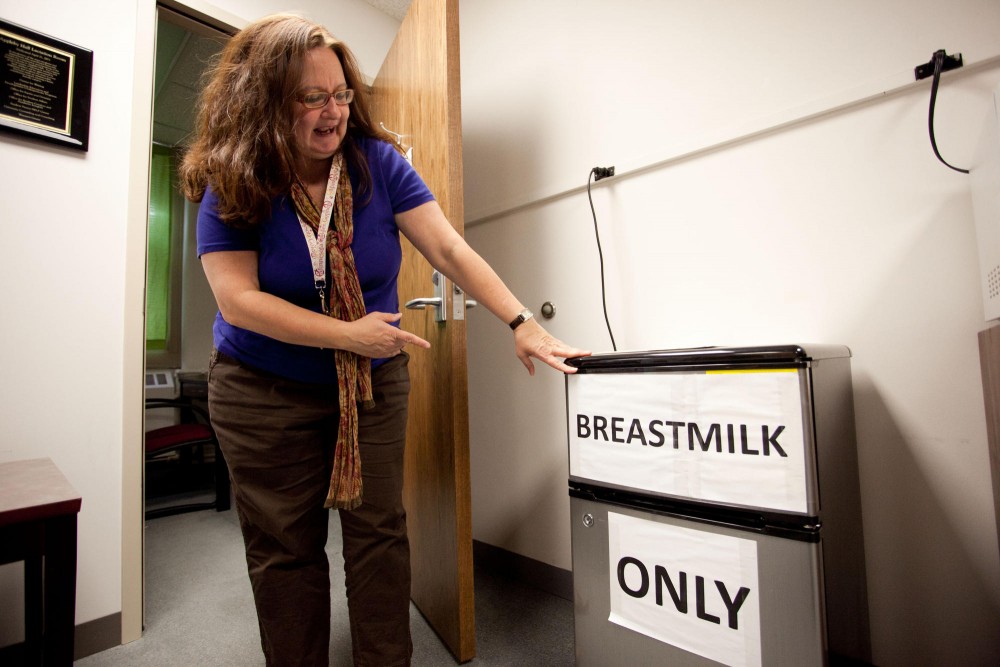When Jennifer Porter came back to work after the February 2011 birth of her son, she had to find a private place to pump breast milk twice daily.
Now, part of a grant from the Minnesota Department of Health could help boost the number of private spaces for nursing mothers like her on campus.
Porter said her office understood the challenges breast-feeding presents and allowed her to use a conference room as a place to pump milk or nurse a baby. But not all departments have the space to give up to nursing mothers and some spots are kept secret for fear they might get crowded.
An ad-hoc committee made of University of Minnesota employees and students strives to ensure there are sufficient on-campus lactation rooms âÄî convenient and quiet spaces where breast-feeding mothers can go to pump breast milk or feed their babies, said Catherine Osborne, a public health nurse at Boynton Health Service.
âÄúBreast-feeding is an important part of my childâÄôs upbringing, so itâÄôs nice to be supported in that personal decision,âÄù Porter said.
Osborne said when the Lactation Advocacy Committee formed two years ago, there were only three official public lactation rooms on campus. That list, which was compiled and publicized, now has 12 lactation spaces.
The Student Parent HELP Center heard in October that it received a two-year grant from the Minnesota Department of Health, and that $6,000 of it was specifically allocated for the lactation committee, said Susan Warfield, co-founder of the committee and program director of the Student Parent HELP Center.
She said the money will be used to hire a consultant who will determine spaces that can be converted into lactation rooms in a cost-effective manner.
The lactation space created in Appleby Hall last year is a prime example of how this can be done with few resources, she said.
The employees in that building portioned off a small part of their lounge and converted it into a lactation space for about $5,000, Warfield said.
It features a desk, chair and fridge exclusively for breast milk.
While it is mandated under Minnesota law to allow space and time for breast-feeding women to pump at work, Osborne said, these rooms are also available to students who arenâÄôt covered under the statute.
Osborne said space is a âÄúpremiumâÄù on the University campus. While some departments create rooms for their employees to breast-feed, they donâÄôt want to share that information with the rest of the University for fear that it might be âÄúoverrun.âÄù
âÄúThat right there tells us that there is a need for more space,âÄù she said.
Warfield said there has been increased and âÄúcritical needâÄù for lactation spaces for students and employees at the University, and a federal push for breast-feeding through the support of the U.S. Surgeon General this year may be behind it.
Breast-feeding is linked to positive health benefits for the infant, like a better immune system and decreased change of chronic diseases, as well as for the mother, which is why employees like Osborne and Warfield encourage the University to have lactation spaces available.
âÄúA woman should feel comfortable and supported to be breast-feeding in the workplace,âÄù Osborne said.
She said breast-feeding is also psychological for a woman because it creates a bond between the mother and child.
The converted rooms often have posted pictures of babies to aid in the lactation process by triggering that emotion.
Osborne said women may lactate anywhere from three months to a year-and-a-half and often need to emit milk around three times a day for 15 minutes.
If a woman does not breast-feed on a consistent schedule, it can be painful, Warfield said.
She said there is often a misconception that all University employees have their own private office to pump in at their convenience.
âÄúThe average woman is not going to feel comfortable pumping or breast-feeding their baby at a public reception desk,âÄù Warfield said.
The committee has drafted a proposal on the benefit and need of nursing mother rooms that it will present to central administration in spring.
Warfield said the committee will recommend that the University provide a central place for employees and students to have concerns and complaints addressed. The proposal also indicates that there is not enough space on campus.
Osborne said the goal is to have a lactation room installed in each new or renovated building.


